
Taking the long view on play in early childhood education
March 1, 2014
NIEER is hosting a blog forum on play-based learning in early childhood education, including posts from national experts in the field. Learn more about the forum here. Concerns about whether preschool and kindergarten have become too stressful and regimented are met head on with concerns that they are academically weak and fail to cognitively challenge children. These conflicts have been intensified by increased demands for assessment and Common Core State Standards driving curriculum in the early grades.
By Larry Schweinhart, President Emeritus, HighScope Educational Research Foundation
The educational value of early childhood activities is determined by how much they contribute to the many dimensions of young children’s development. These include learning how to read, write, add, and subtract – and much, much more. Adding and subtracting depend on the abilities to sort things into categories and count them. Reading and writing depend on the abilities to speak and listen to other people. All these abilities depend on the abilities to think and understand and pay attention, to use one’s senses and move with purpose, to delay gratification and anticipate consequences, to make decisions and take responsibility for one’s actions, and so on.
Multiple-choice educational tests are very good at assessing the parts of reading, writing, adding, and subtracting that involve single right answers answered by individual children. They are not so good at assessing the many abilities that involve interacting with other people in the real world of give and take. The educational testing movement that began a century ago brought objectivity to the measurement of educational objectives by narrowing and distorting these objectives. The few educational objectives based on right answers gained importance, even being viewed by some as the sole objectives of education, as evidenced by the current Common Core State Standards. Further, educational testing has made short-term educational objectives assume greater importance than long-term educational objectives, simply because their achievement can be assessed more easily and cheaply.
It is tempting to surrender to this perspective. Much evidence supports it. It brings objectivity to messy topics such as the evaluation of teachers and educational programs. However, some longer-term research raises questions about the adequacy of this short-term testing perspective. I have spent my career on two such long-term studies.

The HighScope Perry Preschool Study is a rigorous longitudinal study of the effects of a high-quality preschool program on young children born in poverty. Intellectual tests given annually from ages 3 to 10 showed a strong immediate program effect that dissipated after a couple years – the infamous fadeout effect. But as the years went by, it turned out that this finding was misleading: program participants achieved greater school success than their classmates of similar background and went on in adulthood to higher earnings, a higher employment rate, and a lower crime rate.
The HighScope Preschool Curriculum Comparison Study is a rigorous longitudinal study of the effects of three kinds of preschool programs on young children born in poverty – one that concentrated on direct instruction and two that focused on child-initiated learning activities, that is, teachers and children interacting and playing together. The direct instruction program had an edge in intellectual testing as the children started school. But as the years went by, the direct instruction participants had more emotional problems and committed more serious crimes than their classmates who had experienced the interactive preschool programs.
In both studies, short-term educational tests pointed to program failure, but later, real-life measures showed great program success. Such studies suggest that we should be wary of research findings based only on short-term educational tests without confirmation by longer-term real world measures of success. That is not to say that these short-term educational tests should be discarded. They remain an important component of feedback regarding what is worthwhile in education. But they are just one component and not the ultimate source of validity in education.
The dictionary defines play, in part, as the spontaneous activity of children, not directed by adults. If learning to read, write, add, and subtract were the only objectives of early childhood education, play might not have a place in early childhood education, could be seen as a distraction from these sole objectives. But early childhood education has the many objectives listed above, objectives that require social interaction and the spontaneous activity of children. The teacher becomes not only the instructor but also the coach, the orchestrator, the facilitator of this social interaction and play. We might call these the narrow and broad definitions of early childhood education. Narrowly defined early childhood education may have a quick payoff. But it is only broadly defined early childhood education that can fulfill the promise of long-term effects and return on investment.
About NIEER
The National Institute for Early Education Research (NIEER) at the Graduate School of Education, Rutgers University, New Brunswick, NJ, conducts and disseminates independent research and analysis to inform early childhood education policy.
